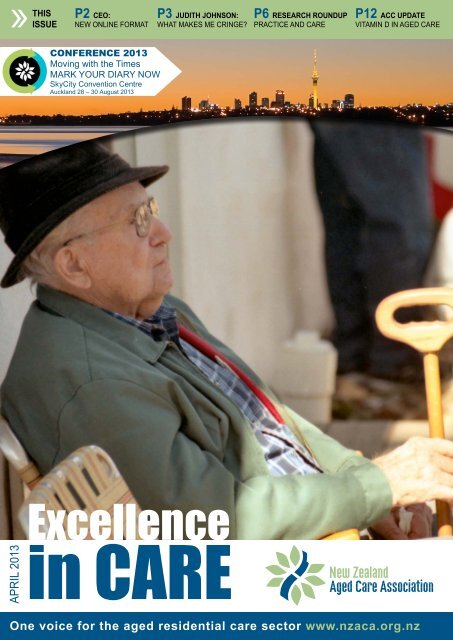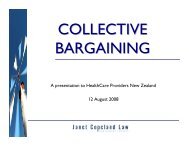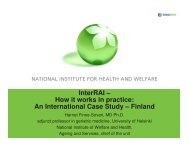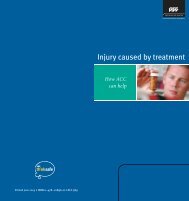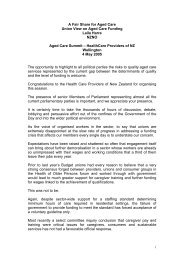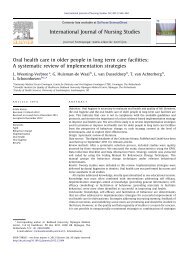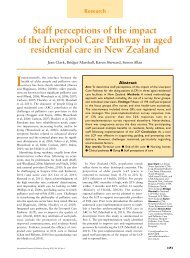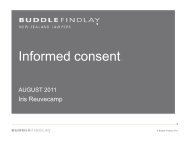Excellence - New Zealand Aged Care Association
Excellence - New Zealand Aged Care Association
Excellence - New Zealand Aged Care Association
You also want an ePaper? Increase the reach of your titles
YUMPU automatically turns print PDFs into web optimized ePapers that Google loves.
THIS<br />
ISSUE<br />
P2 CEO:<br />
NEW ONLINE FORMAT<br />
P3 JUDITH JOHNSON:<br />
WHAT MAKES ME CRINGE?<br />
P6 RESEARCH ROUNDUP<br />
PRACTICE AND CARE<br />
P12 ACC UPDATE<br />
VITAMIN D IN AGED CARE<br />
CONFERENCE 2013<br />
Moving with the Times<br />
MARK YOUR DIARY NOW<br />
SkyCity Convention Centre<br />
Auckland 28 – 30 August 2013<br />
<strong>Excellence</strong><br />
APRIL 2013<br />
in CARE<br />
One voice for the aged residential care sector www.nzaca.org.nz
Clean & Green with ELS <strong>New</strong> <strong>Zealand</strong> Ltd<br />
Our comprehensive range of laundry systems are designed and manufactured to minimise environmental<br />
impact, by optimising use of energy and water, while minimising waste, placing laundry in the area of<br />
sustainable development, with respect to our environment.<br />
A wide range of options for the best fit<br />
Whether you want the basics (robust and reliable) or need the<br />
ultimate in technology for savings and flexibility, we will provide<br />
you with the best product for your business.<br />
Electrolux - the logical answer<br />
to your laundry needs<br />
• Equipment sales / Planning / Laundry Design<br />
• Proffessional Inhouse Training<br />
• Maximise energy and water savings<br />
• Complete aftersales Service & Spare parts Supply<br />
Contact your reliable partner:<br />
PH: (09) 274 9324<br />
Fax: (09) 274 3827<br />
Email: sales@elsnz.co.nz<br />
Web: www.elsnz.co.nz<br />
Our very latest Ozone Laundry System for Cold Water Washing<br />
ELS <strong>New</strong> <strong>Zealand</strong> Ltd<br />
Electrolux Laundry Systems<br />
One voice for the aged residential care sector www.nzaca.org.nz
<strong>Excellence</strong> in CARE April 2013 www.nzaca.org.nz<br />
Advertising<br />
For enquiries regarding<br />
advertising or to place<br />
an advertisement in<br />
<strong>Excellence</strong> in CARE<br />
please contact:<br />
Robyn Gray<br />
National Office<br />
<strong>New</strong> <strong>Zealand</strong> <strong>Aged</strong><br />
<strong>Care</strong> <strong>Association</strong><br />
PO Box 12481<br />
Wellington 6144.<br />
Phone: 04 473 3159<br />
Fax: 04 473 3554<br />
NZACA National<br />
Office Staff<br />
Martin Taylor<br />
CEO<br />
martin@nzaca.org.nz<br />
Robyn Gray<br />
Conference Manager<br />
robyn@nzaca.org.nz<br />
Alyson Kana<br />
Policy Advisor<br />
alyson@nzaca.org.nz<br />
Jennifer Taylor<br />
Administration<br />
jennifer@nzaca.org.nz<br />
Asti Laloli<br />
asti@nzaca.org.nz<br />
Accounts<br />
accounts@nzaca.org.nz<br />
3<br />
5<br />
10<br />
UPfront<br />
2. CEO’s Report<br />
Martin Taylor on the new online format<br />
Features<br />
3. Words from the Wise<br />
What Makes Me Cringe? By Judith Johnson,<br />
Consultant to the <strong>Aged</strong> <strong>Care</strong> Sector<br />
5. Conference 2013<br />
Moving with the Times. MARK YOUR DIARY NOW.<br />
6. Research Roundup<br />
A summary of the latest in evidence-based<br />
practice and care.<br />
8. Infection Protection is in Your Hands<br />
By Judy Forrest Infection Control Consultant<br />
Bug Control <strong>New</strong> <strong>Zealand</strong> Ltd<br />
10. Paying Too Much for your Bread<br />
and Dairy Products<br />
Goodman Fielder: Our Homegrown Food Company<br />
11. Five Ways to Motivate your Staff to<br />
Complete Education Programmes<br />
By Julie Sparks, General Manager, Health Ed Trust<br />
12. Update: Vitamin D Used in<br />
<strong>Aged</strong> <strong>Care</strong> Facilities<br />
By Judith Johnson, Consultant to the <strong>Aged</strong> <strong>Care</strong> Sector<br />
13. NZACA Prefered Suppliers<br />
Disclaimer:<br />
The information in this publication is given in good faith and has been derived from<br />
sources believed to be reliable and accurate. However, neither <strong>New</strong> <strong>Zealand</strong> <strong>Aged</strong><br />
<strong>Care</strong> <strong>Association</strong> nor the publishers accept any form of liability whatsoever for its<br />
contents, including advertisements, editorials, opinions, advice or information, or<br />
any consequence of its use.
UPfront<br />
THE CEO’S MESSAGE<br />
CEO MARTIN TAYLOR<br />
CEO’s Message<br />
NZACA’s <strong>New</strong> Online Magazine<br />
The <strong>New</strong> <strong>Zealand</strong> <strong>Aged</strong> <strong>Care</strong> <strong>Association</strong>’s magazine <strong>Excellence</strong> in <strong>Care</strong> has<br />
undergone a transformation with the <strong>New</strong> Year and moved into the future.<br />
Moving to an online format we hope to make it more accessible to members<br />
and their staff.<br />
Our goal is to provide the best possible content to support you and your business.<br />
Our goal is to<br />
provide the<br />
best possible<br />
content to<br />
support you<br />
and your<br />
business<br />
The content of this magazine and future issues has also undergone a face lift.<br />
We are looking to provide up-to-date information, support and articles that are<br />
topical and relevant to our sector. <strong>New</strong> regular sections of this magazine include<br />
elder law information from Barrister Wendy Aldred, “Words from the Wise” sees<br />
aged care consultant Judith Johnson share her knowledge and experience from<br />
decades of working, owning and consulting to the sector, and “Bugs and More”<br />
has information from infection control consultant Judy Forrest.<br />
We are very proud to include the “Research Round Up” section offering some<br />
of the latest clinical articles specifically on aged care. We hope this section will<br />
be of great benefit to your nursing staff.<br />
<strong>Excellence</strong> in <strong>Care</strong> will be published three times a year and sent directly to<br />
your inbox.<br />
We would also like to hear from members with suggestions on topics you would<br />
like us to cover or articles you may wish to have published.<br />
We hope you enjoy the new magazine.<br />
VAN INTERIORS<br />
mobility | seating | commercial<br />
NZ’S LEADING<br />
VAN INTERIOR<br />
SPECIALISTS<br />
www.jel.co.nz | freephone 0800 274427 | email info@jel.co.nz<br />
2. <strong>Excellence</strong> in CARE APRIL 2013
Feature<br />
WORDS FROM THE WISE<br />
WORDS FROM THE WISE<br />
What makes me cringe?<br />
By Judith Johnson, Consultant to the <strong>Aged</strong> <strong>Care</strong> Sector<br />
When asked to write an item on the above<br />
topic, the first thing that came to mind<br />
was ‘attitude’ – how the attitude of various<br />
people throughout the aged care sector<br />
(and beyond) impacts on the actual care<br />
delivered, and it is usually their attitude<br />
that makes me cringe. For example, the<br />
resident backing away whilst being fed<br />
from the spoon of food as it was too hot<br />
– the carer didn’t consider that, or possibly<br />
didn’t want to, as she was more interested<br />
in getting the task done. (A spoonful on the<br />
carer’s forearm will hopefully keep food<br />
temperature to the fore of her mind when<br />
feeding residents, and the consequences<br />
ought to influence her attitude, should the<br />
incident occur again.)<br />
There are millions of hours of excellent care delivered to<br />
residents every year, but how often, as management, do<br />
we turn a ‘blind eye’ (consciously or not) to the attitude of<br />
some we deal with?<br />
Should we accept an assessment of a resident which we<br />
believe to be inaccurate, or routinely go through appeals<br />
to the assessment agency, so causing delays to being<br />
adequately paid? Delays may save government money,<br />
but is the attitude that this is acceptable appropriate?<br />
In the interim it is very difficult to deliver the higher level<br />
of care on the lower income and if it is being delivered<br />
to the client in question, how much is it eroding the care<br />
delivered to others in the facility?<br />
Should we accept the staff attitude when they become<br />
focused on the ‘task’ and how quickly tasks can be done,<br />
rather than on the individual resident they are caring for?<br />
Why does the resident get persuaded to go to bed at<br />
7.30pm, instead of attending the evening’s entertainment<br />
– which she wanted to do? I believe it was so the staff<br />
could ‘finish their tasks earlier’.<br />
The attitude that the residents are<br />
just another chore to be attended<br />
to makes me cringe.<br />
If you can’t happily wait tables don’t be a waiter.<br />
If you can’t happily deliver care then don’t be a carer.<br />
It sounds simple but the reality is, as managers, we<br />
often have staff whose attitudes do not promote good<br />
care delivery or happy teams. The reason residents are<br />
not always treated as individuals usually comes down<br />
to attitude. Although it may be plastered over the walls<br />
that residents are to be treated with respect and as<br />
individuals (another tick in the audit box), does it<br />
influence the behaviour of the carer?<br />
Many studies have been undertaken on the relationship<br />
between attitudes and behaviour, and in the 1970s there<br />
was doubt about whether attitudes could predict behaviour.<br />
However, it is now considered that attitudes do contribute<br />
to behaviour and those attitudes can be influenced.<br />
The theory of reasoned action assumes that people<br />
deliberate about the wisdom of a given course of action<br />
(Ajzen & Fishbein, 1980). Research shows that when<br />
people are motivated and opportunity is high, they engage<br />
in the effort necessary to retrieve specific details from<br />
memory. However, when people are less motivated or<br />
under time pressure, they resort to their overall attitude to<br />
the situation.<br />
For example, I am in a hurry and need to transfer<br />
Resident G. My attitude is that I am strong enough to<br />
do it on my own without a hoist, so I do that.<br />
As management, you would want me to stop and<br />
consider what harm I could be doing to the resident<br />
and/or myself (whatever motivates), and that I have the<br />
opportunity to access equipment (hoist) to undertake the<br />
transfer. If I have received education and have become<br />
competent at using the hoist, I will not consider it to be<br />
3. <strong>Excellence</strong> in CARE APRIL 2013
Feature<br />
WORDS OF WISDOM<br />
excessively time-consuming. Also, you might have<br />
detailed the disciplinary action you may take should I<br />
not transfer as per the residents care plan. My attitude<br />
has been influenced. Management should also be<br />
mindful that some kinds of people typically display greater<br />
attitude-behaviour consistency than do others (Rhodes &<br />
Bailey, 1983). Some are guided by their internal feelings<br />
and others tend to rely heavily on cues in the situation to<br />
decide how to behave. People often behave as they<br />
believe others expect them to behave.<br />
The above should factor in when we consider what<br />
influences are being exerted on staff. Are all our team<br />
members providing positive influence? As management,<br />
does our attitude towards residents/families provide a<br />
positive influence? For example, if we aren’t placing<br />
importance on the input from families into the care<br />
delivered, will staff?<br />
Attitude is Everything<br />
It sure is, but we cannot always determine a person’s<br />
attitude at interview – or even be responsible for<br />
employing all the staff we have in our team – so we<br />
need to focus on how we can influence attitude.<br />
A positive ‘service delivery attitude’ goes a long way to<br />
having happy residents, families and staff and making a<br />
long-term viable business.<br />
leaders in emergency Call systems<br />
TrusT The experTs in Call sysTems To assisT you<br />
Selecting a nurse call system is a daunting task. With so<br />
many technologies how do you choose the right solution<br />
and the best partner?<br />
At Austco, we understand aged care. Over the past 25 years,<br />
more than 6000 facilities have trusted us to assist them.<br />
Call us for an obligation free consultation.<br />
aBouT ausTCo<br />
Austco is a wholly owned subsidiary of Azure Healthcare<br />
Ltd, an international provider of healthcare communication<br />
and clinical workflow management<br />
solutions.<br />
www.austco.co.nz<br />
Austco<br />
info@austco.co.nz (09) 271 3712<br />
<strong>Aged</strong> <strong>Care</strong> ACA (92x140mm).indd 1<br />
4. <strong>Excellence</strong> in CARE APRIL 2013
CONFERENCE 2013<br />
MOVING WITH THE TIMES<br />
The <strong>New</strong> <strong>Zealand</strong> <strong>Aged</strong> <strong>Care</strong> <strong>Association</strong>’s<br />
Annual Conference for 2013 will be held at<br />
SkyCity Convention Centre, Auckland,<br />
from Wednesday 28th August to Friday 30th August.<br />
NZACA promotes excellence in care, choice and<br />
security for all within the aged care industry and<br />
for older <strong>New</strong> <strong>Zealand</strong>ers who require our support<br />
and care. The <strong>Association</strong> strives to improve the<br />
political, economic and social environment in which<br />
the industry operates.<br />
MARK YOUR DIARY NOW<br />
NZ <strong>Aged</strong> <strong>Care</strong> Conference<br />
SkyCity Convention Centre Auckland<br />
28 – 30 August 2013<br />
Our Conference Sponsors<br />
2013 Conference: Moving with the Times<br />
Throughout the economy, many sectors are<br />
facing changing consumer expectations, changing<br />
regulations and changing technology. All of these<br />
changes have an impact on existing businesses<br />
and only those operators who adapt and plan for<br />
the future will have successful business models.<br />
The aged care sector is no different, which is why<br />
the theme of this year’s conference is ‘Moving with<br />
the Times’. This year we hope to focus delegates’<br />
minds on what they need to do in the short and<br />
medium term to maintain and grow as aged care<br />
operators in the face of rapid and inevitable change.<br />
Registration and further details will<br />
be out at the end of April.<br />
5. <strong>Excellence</strong> in CARE APRIL 2013
Feature<br />
RESEARCH ROUNDUP<br />
Research Roundup<br />
A summary of the latest in evidence-based practice and care.<br />
The following is a selection of recently published<br />
research reports, relevant to those working in the aged<br />
residential care sector, which may help improve the<br />
safety, wellbeing or quality of life of residents. The<br />
reports have been summarised and translated into<br />
everyday language. The literature search and summary<br />
was prepared by Equinox Health Ltd.<br />
1. Identifying <strong>New</strong> Residents at Risk of Falling<br />
Leland, N. E., P. Gozalo, et al. (2012). Falls in newly admitted<br />
nursing home residents: a national study. Journal of the<br />
American Geriatrics Society 60(5): 939-945.<br />
The objective of this study, conducted in the United States,<br />
was to examine the relationship between nursing home<br />
organisational characteristics and falls in newly admitted<br />
residents. All residents admitted to nursing homes in the US<br />
undergo a full assessment at 30 days post admission. The<br />
research involved examining the information gathered at these<br />
assessments to discover the characteristics of residents who<br />
had suffered a fall in this period and those of the facilities in<br />
which they resided.<br />
The most significant finding was that 21% of residents had<br />
suffered a fall in the first 30 days post admission. The most<br />
prevalent risk factors for falling were:<br />
• previous history of falls<br />
• habitual wandering<br />
• cognitive impairment<br />
• Parkinson’s Disease<br />
• use of antipsychotic medication.<br />
The authors also looked at organisational characteristics of<br />
the nursing homes, specifically staff makeup. They found<br />
that higher numbers of certified nursing assistants, a similar<br />
position to caregiver, were associated with fewer falls than<br />
higher numbers of registered nurses. They conclude that<br />
this was most likely because caregivers are present during<br />
activities that are associated with the greatest risk of falling,<br />
e.g. toileting and transfers. The findings were reported in<br />
general terms rather than specific percentages and ratios per<br />
resident and the authors acknowledged that this is an area for<br />
further research.<br />
To view this research report please visit:<br />
- www.nzaca.org.nz/publication/research-documents.htm<br />
2. Learning from Medication Incidents to<br />
Improve Resident Safety<br />
Tariq, A., A. Georgiou, et al. (2012). Medication incident<br />
reporting in residential aged care facilities: limitations and<br />
risks to residents’ safety. BMC Geriatrics 12: 67.<br />
This qualitative study explored the challenges that aged<br />
care facilities face regarding the accurate, timely reporting<br />
of medication incidents. The research took place in three<br />
aged care facilities in Australia and involved semi-structured<br />
interviews with staff, reviewing completed medication incident<br />
6. <strong>Excellence</strong> in CARE APRIL 2013<br />
reports and observing staff in the workplace. The aim was<br />
to attain a complete picture of the factors that influence<br />
medication incident reporting. The key findings of the<br />
research were:<br />
• The medication incident report forms contained<br />
information of variable quality and were usually<br />
handwritten in free text, which was sometimes difficult<br />
to read and interpret.<br />
• The information gathered was limited to the actual incident<br />
and did not explore any causal or contributory factors that<br />
may have led to the incident.<br />
• There was little or no information about the impact of the<br />
incident on the resident and the actions taken to minimise<br />
any harm related to the incident<br />
• Time constraints meant that reports were often completed<br />
at the end of shifts, or even later, and the paper-based<br />
system meant information was sometimes lost.<br />
• The authors acknowledge that, due to the complexity of<br />
the medication management processes in residential<br />
aged care, a completely error-free environment is<br />
unlikely. However, they make several recommendations to<br />
increase the accuracy and meaningfulness of information<br />
gathered. These include:<br />
- a medication incident reporting process that enables<br />
the identification of the root cause of incidents so<br />
that systems and processes around medication<br />
management can be examined and adjusted if<br />
necessary<br />
- a process that facilitates the seamless flow of<br />
accurate, timely information between key<br />
stakeholders to encourage a multi-disciplinary<br />
approach to medication incident management.<br />
The authors suggest that the most effective way to achieve<br />
the above is with an electronic reporting system that is<br />
integrated with the facility’s resident management ICT system.<br />
To view this research report please visit:<br />
- www.nzaca.org.nz/publication/research-documents.htm<br />
3. Staff Education Improves Resident Nutrition<br />
Beattie, E., M. O’Reilly, et al. (2013). How much do residential<br />
aged care staff members know about the nutritional needs of<br />
residents? International Journal of Older People Nursing, 13<br />
Feb 11. doi: 10.1111/opn.12016 (in press).<br />
The aim of this research was to identify the knowledge,<br />
practices and attitudes of staff regarding resident nutrition.<br />
The study took place within one residential care facility in<br />
Brisbane, Australia, and was part of a larger project focusing<br />
on improving the nutritional intake of people with dementia.<br />
A questionnaire was completed by all staff involved with<br />
resident meals, including nurses, caregivers and catering staff.<br />
The authors found significant gaps in some areas of nutritional<br />
knowledge. These included:<br />
• specific daily fluid requirements for frail older people<br />
• understanding of specific nutrients, for example the<br />
relationship between vitamin C and iron uptake<br />
• the importance of protein for wound healing.
Other factors identified by staff as impacting negatively on the<br />
nutritional status of residents included limited time to fully assist<br />
those who need it at meal times, and limited understanding<br />
of how to perform a comprehensive nutritional assessment.<br />
Interestingly, the authors noted that the study participants<br />
exhibited considerable interest in nutrition issues throughout<br />
the study.<br />
Factors that improve resident nutritional status identified by the<br />
authors include:<br />
• education in the workplace to raise the profile of nutrition<br />
and hydration and enhance staff knowledge<br />
• the use of simple screening tools to identify residents as<br />
risk of malnutrition<br />
• Support and mentoring to improve staff confidence in<br />
managing the behavioural factors that impact on nutrition.<br />
To view this research report please visit:<br />
- www.nzaca.org.nz/publication/research-documents.htm<br />
4. Do PPIs Increase Mortality in Frail<br />
Older Residents?<br />
Teramura-Gronblad, M., J. S. Bell, et al. (2012). Risk of death<br />
associated with use of PPIs in three cohorts of institutionalized<br />
older people in Finland. Journal of the American Medical<br />
Directors <strong>Association</strong> 13(5): 488 e489-413.<br />
• Proton-pump inhibitors (PPIs) include drugs such as<br />
omeprazole, pantoprazole and lansoprazole, which<br />
are commonly prescribed for upper GI tract disorders<br />
and protection against GI toxicity associated with<br />
nonsteroidal anti-inflammatory drugs (NSAIDs). This<br />
research compared the risk of death associated with PPIs<br />
in three cohorts of institutionalised older people in Finland.<br />
The three cohorts were:<br />
1. those living in assisted living facilities – mainly<br />
independent who may require assistance with<br />
some ADLs.<br />
2. long-term care hospitals – very frail, often bed-bound,<br />
needing 24-hour nursing care<br />
3. acute geriatric wards or nursing homes – older people<br />
with disabilities and often with dementia but with some<br />
functioning, e.g. they may be independently mobile.<br />
The research involved gathering initial information about the<br />
participants, approximately 1,300 older people, then following<br />
them for one year.<br />
The information gathered included:<br />
• demographic details<br />
• number and severity of co-morbidities<br />
• level of dependency and nutritional status<br />
• the presence of delirium.<br />
The research showed the use of PPIs was not associated<br />
with increased mortality in cohort 1 (those in assisted living<br />
facilities). These people generally had better nutritional status<br />
and less disability that those in cohorts 2 and 3. However, the<br />
use of PPIs was associated with increased mortality in cohorts<br />
2 and 3. These cohorts represent older people more vulnerable<br />
to infections, hip fractures and strokes. The overuse of PPIs has<br />
received recent international attention and the authors suggest<br />
that further research specifically targeting frail older people<br />
would provide greater insight into this controversial subject.<br />
To view this research report please visit:<br />
- www.nzaca.org.nz/publication/research-documents.htm<br />
5. Person-Centred <strong>Care</strong> in <strong>Aged</strong> <strong>Care</strong> Facilities<br />
Brownie, S. and S. Nancarrow (2013). Effects of personcentered<br />
care on residents and staff in aged-care facilities:<br />
a systematic review. Clinical Interventions in Aging 8: 1-10.<br />
The reason for this systematic review was to evaluate the<br />
evidence for replacing the traditional institutional model of care<br />
with a person-centred approach. The authors conducted a<br />
literature search of six major databases to find relevant articles<br />
and reports regarding person-centred care in aged residential<br />
care facilities. They were looking specifically for experimental<br />
studies that included measurable interventions.<br />
The interventions included:<br />
• environmental enhancement<br />
• opportunities for social interaction<br />
• continuity of care<br />
• staff empowerment<br />
• individualised care.<br />
There were three main models of person-centred care<br />
identified: The Eden Alternative, Green House model; and<br />
Wellspring (the Wellspring Innovative Solutions Inc). As well<br />
as these established models, the authors found several<br />
reports about facility-specific person-centred care projects.<br />
The authors found significant evidence that person-centred<br />
interventions were associated with improvements in the<br />
psychological status of residents and reduced levels of<br />
agitation in residents with dementia. They also found<br />
improvements in staff satisfaction, particularly with regard<br />
to being able to provide individualised care. However, the<br />
authors caution that the introduction of person-centred care was<br />
also associated with increased resident falls, and they recommend<br />
the adoption of this model be accompanied by<br />
an environmental safety audit.<br />
To view this research report please visit:<br />
- www.nzaca.org.nz/publication/research-documents.htm<br />
The researchers were able to compare the time to death<br />
between those who were taking PPIs and those who weren’t,<br />
within the three cohorts.<br />
7. <strong>Excellence</strong> in CARE APRIL 2013
Feature<br />
INFECTION PREVENTION<br />
INFECTION PREVENTION<br />
IS IN YOUR HANDS<br />
By Judy Forrest Infection Control Consultant<br />
Bug Control <strong>New</strong> <strong>Zealand</strong> Ltd<br />
Effective Hand Hygiene is the single<br />
most important strategy in preventing<br />
the transmission of infection.<br />
In 1846 Ignas Semmelweiss, known as the Father of<br />
Infection Control, demonstrated that hand washing could<br />
prevent infections, yet more than 150 years later we are<br />
still trying to convince and remind staff of the importance<br />
of this protocol in preventing infection transmission.<br />
Staff often don’t realise they have germs on their hands<br />
because they can’t see them. Nurses, caregivers and<br />
other healthcare workers can pick up hundreds or even<br />
thousands of bacteria on their hands when carrying out<br />
simple tasks in the workplace. These bacteria can then<br />
be passed on the residents they care for, surfaces they<br />
touch and equipment they use. It’s important to wash<br />
your hands frequently. Did you know that microbes can<br />
live on surfaces anywhere from a few minutes to several<br />
months? Imagine these disease-causing microorganisms<br />
living on your computer keyboard, a light switch, or even<br />
on the lift button!<br />
Studies have identified that poor compliance with hand<br />
hygiene routines has been attributed to a number of<br />
factors including:<br />
• heavy workloads<br />
• takes too much time<br />
• hands don’t appear dirty<br />
• problems with skin irritation<br />
• sinks poorly located.<br />
The Centers for Disease Control and Prevention (CDC)<br />
recommends washing thoroughly and vigorously with<br />
soap and water for at least 20 seconds, followed by<br />
hand-drying with a paper towel. In the absence of running<br />
water, an alcohol-based hand rub can be used in place of<br />
soap and water. A good hand wash takes about as long<br />
as it does to sing “Happy Birthday,” so some recommend<br />
washing your hands for the duration of this simple tune.<br />
Surprisingly, most people don’t know when or how to<br />
effectively wash their hands!<br />
The 5 Moments of Hand Hygiene<br />
The World Health Organisation identifies 5 key moments<br />
when hand hygiene should be performed, using soap and<br />
water or an alcohol-based hand rub.<br />
Moment 1<br />
To protect against acquiring harmful germs from<br />
the hands of others, hands should be cleaned after<br />
shaking hands, assisting a resident to move, touching<br />
an invasive device such as a catheter connected to a<br />
resident, bathing, dressing, brushing hair, putting on<br />
personal protective equipment, taking a pulse, BP,<br />
temperature, preparation and administration of oral<br />
medications and when performing oral care and feeding.<br />
Moment 2<br />
To protect the resident from harmful germs (including<br />
their own) entering their body, hand hygiene should be<br />
performed before a procedure such as insertion of a<br />
needle into a resident’s skin or any assessment,<br />
treatment and resident care where contact is made<br />
with non-intact skin or mucous membrane (i.e. wound<br />
dressings).<br />
Moment 3<br />
To protect yourself, and the healthcare surroundings,<br />
from harmful resident germs, hands should be cleaned:<br />
• after contact with a used urinary bottle/ bedpan or<br />
used specimen jars/ pathology samples;<br />
• after cleaning dentures, spills of urine, faeces,<br />
or vomit; or<br />
• after contact with any blood, saliva, mucous,<br />
semen, tears, urine, faeces, vomitus.<br />
Moment 4<br />
Hand hygiene should be performed after touching a<br />
resident, to protect yourself, and the healthcare<br />
surroundings you are working in, from harmful<br />
resident germs and to reduce the opportunity of<br />
transfer of these germs to others.<br />
Moment 5<br />
To protect yourself, and the healthcare surroundings,<br />
from harmful resident germs by performing hand hygiene<br />
after touching the resident’s immediate surroundings,<br />
even when the resident has not been touched.<br />
8. <strong>Excellence</strong> in CARE APRIL 2013
Use of alcohol-based hand rubs<br />
Alcohol-based hand rub is the gold standard of care for<br />
hand hygiene practice in healthcare settings, whereas<br />
hand washing is reserved for situations when hands are<br />
visibly soiled, or in the care of a patient with C. difficile.<br />
Using alcohol-based hand rubs may be more beneficial<br />
than using traditional soap and water in some instances<br />
because they:<br />
• require less time to use<br />
• result in a significantly greater reduction<br />
in bacterial numbers than soap and water,<br />
in many clinical situations<br />
• cause less irritation to the skin<br />
• can be made readily accessible to workers<br />
• are more cost effective.<br />
Hand care is also important<br />
It is important to ensure the skin on your hands remains<br />
intact, with no cuts, sores, scratches or burns – all areas<br />
where bacteria can enter through the skin. However, if<br />
you come to work with a cut, abrasions or other skin<br />
lesions, these MUST be covered with a waterproof<br />
dressing prior to commencing work.<br />
The frequent use of hand creams and emollients can<br />
prevent dehydration, damage to the skin, skin shedding<br />
and loss of lipids and can restore the water-holding<br />
capacity of the skin. A good emollient can create a<br />
chemical barrier, which may prevent cross-contamination.<br />
It should be remembered that some hand creams and<br />
emollients can neutralize the effects of chlorhexidine,<br />
so compatible hand hygiene products are essential.<br />
Long fingernails can harbour bacteria, so nails should<br />
be kept short and scrupulously clean. False fingernails<br />
and chipped or scratched nail polish can harbour<br />
bacteria and should not be worn for clinical care.<br />
Jewellery, other than a plain wedding band, should not be<br />
worn – again, because bacteria can live and thrive under<br />
jewellery.<br />
Remember: Effective Hand Hygiene is the single most<br />
important thing you can do to prevent the transmission<br />
of infection to yourself, your residents and your family.<br />
Infection Prevention is in your hands!<br />
The specialist Health & <strong>Aged</strong> <strong>Care</strong> team at Jones Lang<br />
LaSalle provides valuations and property consultancy advice to<br />
individual operators, major institutions, public companies, private<br />
investors, lenders and developers.<br />
We help clients future proof their assets by anticipating the<br />
expectations of the next generation.<br />
Our in-depth understanding of retirement and aged care market<br />
drivers and trends creates a clear competitive advantage for our<br />
clients to:<br />
• Maximise their investment return<br />
• Minimise property risk<br />
• Avoid building obsolescence<br />
• Continue to align product offerings with latest consumer trends<br />
Michael Nimot<br />
Director, Health & <strong>Aged</strong> <strong>Care</strong><br />
+64 9 914 9723<br />
michael.nimot@ap.jll.com<br />
Matt Straka<br />
Registered Valuer<br />
+64 9 363 0208<br />
matt.straka@ap.jll.com<br />
<strong>Aged</strong> <strong>Care</strong> Specialists<br />
Nigel Fenwick<br />
Associate Director<br />
+64 4 971 1319<br />
nigel.fenwick@ap.jll.com<br />
Lance Collings<br />
Director<br />
+64 3 341 8215<br />
lance.collings@ap.jll.com<br />
www.joneslanglasalle.co.nz<br />
9. <strong>Excellence</strong> in CARE APRIL 2013
Feature<br />
GOODMAN FIELDER<br />
Paying too much<br />
for your bread and<br />
dairy products?<br />
Check out the Vogel range available to NZACA members<br />
Free phone: 0800242424<br />
For enquiries contact: dncallcentre@goodmanfielder.co.nz<br />
Orders: orders@goodmanfielder.co.nz<br />
Join the NZACA Preferred supplies scheme with Goodman<br />
Fielder<br />
For new accounts, contact the Outbound Sales Team on<br />
newaccounts@goodmanfielder.co.nz<br />
Remember to mention you are a current member of NZACA.<br />
Q&A’s – Vogel’s Gluten Free Bread<br />
Q<br />
A<br />
Q<br />
A<br />
Q<br />
A<br />
Q<br />
A<br />
Where is Vogel’s Gluten Free bread made?<br />
Vogel’s Gluten Free bread is made at our dedicated gluten<br />
free bakery in Huntly - and it is distributed throughout <strong>New</strong><br />
<strong>Zealand</strong> from this site.<br />
Is the Vogel’s Gluten Free bread made in the same<br />
bakery as ‘wheat and gluten’ containing products?<br />
No –definitely not. Vogel’s Gluten Free bread is baked<br />
IN A DEDICATED GLUTEN FREE BAKERY. Absolutely<br />
NO wheat or gluten enters this bakery –it is completely<br />
separate from any ‘standard bread or baked goods’.<br />
Why is the bread packaged differently to<br />
ordinary bread?<br />
Vogel’s Gluten Free bread uses vacuum packing<br />
technology which helps retain freshness. This packaging<br />
technology gives Vogel’s Gluten Free bread two weeks<br />
shelf life.<br />
How long will my gluten free bread keep once I have<br />
opened the pack?<br />
Once opened, we suggest you place the bread in its<br />
packaging into a plastic bag and seal to retain freshness,<br />
then store in a cool, dry place and use within 3 days.<br />
Q<br />
A<br />
Q<br />
A<br />
Q<br />
A<br />
Q<br />
A<br />
Q<br />
A<br />
Q<br />
A<br />
Q<br />
A<br />
Is the Vogel’s Gluten Free bread packaging<br />
‘resealable’.<br />
Unfortunately no. This is the case for Burgen and Venerdi<br />
as well. Many people tuck the open top down and pop the<br />
pack into the freezer –alternatively, people can put into a<br />
plastic bag & seal up.<br />
What ingredients do you use in the gluten free<br />
products instead of wheat?<br />
Maize, rice, soy and tapioca starches and flours<br />
Are there any Preservatives in the Vogel’s Gluten<br />
Free bread?<br />
The Vogel’s Gluten Free bread does contain ‘’vinegar’<br />
which helps is ‘natural’ and helps retain freshness –<br />
however, there are no artificial preservatives in the recipe.<br />
Does the Vogel’s Gluten Free bread contain milk<br />
and soy?<br />
Yes, Vogel’s Gluten Free bread does include milk and soy<br />
in the recipe. This helps the bread stay fresher for longer<br />
and gives it a better texture.<br />
Is the Vogel’s Gluten Free low GI like the other<br />
Vogel’s breads?<br />
Unfortunately no. The grains in Vogel’s (which contain<br />
gluten) are a key ingredient in making the ‘standard’ Vogel’s<br />
bread low GI. Because we have to omit wheat containing<br />
grains from our gluten free recipes, it prohibits it from being<br />
low GI.<br />
Is the Vogel’s Gluten Free bread high fibre?<br />
Unfortunately no. Typically the ingredients used in gluten<br />
free products contain some fibre but not nearly as much as<br />
gluten containing grains.<br />
Is the Vogel’s Gluten Free bread low in fat?<br />
Unfortunately no. There is a higher level of canola oil<br />
in the gluten free bread recipes to help with freshness<br />
& moistness.<br />
Q<br />
A<br />
Q<br />
A<br />
Q<br />
A<br />
Q<br />
A<br />
What is the shelf life of the Vogel’s Gluten Free bread?<br />
14 days from day of manufacture<br />
Can I freeze the Vogel’s Gluten Free bread?<br />
Yes, it can be stored frozen for up to 3 months.<br />
Do I need to store my gluten free bread in the fridge?<br />
No. Once opened, we suggest you place the bread in its<br />
packaging into a plastic bag and seal to retain freshness,<br />
then store in a cool, dry place and use within 3 days.<br />
Is the Vogel’s Gluten Free bread packaging ‘easy peel?<br />
Unfortunately no. The seals need to be permanent seal<br />
at this stage on the bread (like Burgen and Venerdi) –<br />
however, we are running trials on the ‘easy peel’ type of<br />
packaging and would like to move to this as soon as<br />
possible.<br />
10. <strong>Excellence</strong> in CARE APRIL 2013
Feature<br />
HEALTH ED TRUST<br />
Five Ways to Motivate<br />
your Staff to Complete<br />
Education Programmes<br />
How important is education to your organisation?<br />
Health Ed Trust recently conducted Assessor Workshops<br />
in ten locations from Auckland to Invercargill. The first<br />
session each day was ‘How to Motivate Students’.<br />
The following is the combined wisdom from about<br />
300 attendees.<br />
Number One<br />
Fostering a great education culture in any organisation starts at<br />
the top. If Management and Assessors expect achievement and<br />
qualifications then this expectation flows through to all staff. A<br />
combination of enthusiasm, recognition and rewards backed up by<br />
company policy appear to set the culture that is the main contributor<br />
to high achievements.<br />
Allowing paid time for the Assessor to run classes and mark<br />
papers sends a message to the whole facility. A survey of<br />
attendees showed that paid time allocated for training activities<br />
varied from a challenging one hour a week to a generous one day<br />
a week. Of course, the size of the facility has a huge<br />
bearing on the time required.<br />
Number Two<br />
Recognition can be a powerful motivator; some students craved<br />
this more than rewards. Suggestions include the following.<br />
• Ceremonies where badges, certificates or flowers are<br />
presented are always appreciated. Morning/afternoon teas<br />
in front of other staff and residents, or BBQs with all the family<br />
invited give the caregivers a real sense of achievement.<br />
• One Assessor told of students being handed certificates<br />
as they arrive, without any presentation – this is a huge<br />
recognition opportunity wasted. This also devalues the<br />
achievement.<br />
• The Health Ed Trust Honours Board is used with great effect in<br />
many places. One facility puts the student’s name on the<br />
Board, without any of the coloured achievement squares,<br />
as soon as they start the programme. This motivates the<br />
caregivers to finish so their names can have the tags added as<br />
soon as possible. If your facility does not have an Honours<br />
Board, then frame the certificate and hang it in the foyer.<br />
• Only allowing caregivers to work in sought-after areas if they<br />
have completed education to a certain level.<br />
• Talking about how good the qualification will look on their CV<br />
and how the qualification is recognised throughout NZ.<br />
• Replacing the caregiver’s uniform with a different coloured<br />
uniform, to show that they are a trained staff member, is a<br />
recognition technique that works well at another facility.<br />
• Status symbols. One facility gives out an expensive-looking key<br />
ring to staff that have completed the programme. These are<br />
valued and carried with pride. Others give graduation bears.<br />
• Some Assessors reported how some caregivers like to set an<br />
example for their children.<br />
Number Three<br />
Rewards each time a programme is completed – suggestions<br />
include the following.<br />
• Pay increments. Varied from 10c to $1 per hour.<br />
• A paid day off.<br />
• $50 bonus.<br />
• One facility pays the caregiver 30 minutes for every hour they<br />
attend an education session.<br />
Number Four<br />
Peer Pressure. Taking small groups through the education<br />
programmes at one time can be used as a motivating factor.<br />
(Small groups were considered to be the best way to run an<br />
education programme onsite.)<br />
• Students love to receive their results quickly and see how they<br />
are progressing with each module. One Assessor refuses to mark<br />
any of the students’ modules until the whole group’s modules are<br />
handed in. If one student dares not to have papers in on time, the<br />
rest of the group applies pressure to the miscreant student.<br />
• Create a waiting list. Only take a few students through at a time.<br />
Take special interest in this group – everyone wants what they<br />
can’t have.<br />
Number Five<br />
Although only to be used as a last resort when nothing else<br />
works, a possibility is to include achieving the education<br />
programme as a requirement in the caregiver’s employment<br />
contract. When continued requests and encouragement do<br />
not produce any results, the issue can be managed as a<br />
performance issue.<br />
Why don’t caregivers want to complete programmes?<br />
It is always handy to know these reasons so objections can be<br />
overcome from the beginning.<br />
• Fear: This was first on the list at almost all locations. Mainly<br />
this was fear of failure, as caregivers had not done well at<br />
school, had English as a second language or thought the work<br />
would be too difficult. Suggestion: start with an easier Module.<br />
Encourage, encourage and encourage. Thousands of caregivers<br />
have completed ACE Courses.<br />
• Too busy: Well, can’t we all say that?! Break the assessment<br />
down and ask the caregiver to complete one or two questions<br />
each night.<br />
• Know it all: <strong>Care</strong>givers who have been employed for a long time<br />
say they don’t need to do this course. The best answer to this:<br />
“You will fly through it, then… You can help teach the others in<br />
the group.”<br />
• Too expensive: convince Management to at least go halves<br />
in the cost. Many more facilities are now paying all the<br />
processing fees for students.<br />
• Too close to retirement: Health Ed Trust has had several<br />
caregivers who are over 70 complete this course. It has been<br />
proven that it is very good for the brain cells to learn new things!<br />
Any other suggestions would be gratefully received.<br />
By Julie Sparks<br />
General Manager<br />
Health Ed Trust<br />
Ph 03 3798519<br />
Email Julie@healthedtrust.org.nz<br />
11. <strong>Excellence</strong> in CARE APRIL 2013
Feature<br />
ACC UPDATE<br />
<br />
Update:<br />
Vitamin D Used in <strong>Aged</strong> <strong>Care</strong> Facilities<br />
Judith Johnson - Consultant to the <strong>Aged</strong> <strong>Care</strong> Sector<br />
Current national supplementation<br />
rate for <strong>New</strong> <strong>Zealand</strong><br />
• Data provided by the Ministry of Health indicates that around 75% of the 65+ population who reside in residential care are<br />
receiving Vitamin D supplementation.<br />
• There cannot be a direct causal link made between the use of Vitamin D in residential settings and a reduction in claims,<br />
due to the number of variables involved.<br />
However as seen in the chart below, claims have reduced as supplementation levels have increased.<br />
Results<br />
ACC claims for falls in ARC vs Vitamin D prescribing<br />
16000<br />
80%<br />
14000<br />
70%<br />
Number of 65+ fall claims by those in<br />
residential care<br />
12000<br />
10000<br />
8000<br />
6000<br />
4000<br />
60%<br />
50%<br />
40%<br />
30%<br />
20%<br />
Percentage of Vitamin D Prescribing<br />
2000<br />
10%<br />
0<br />
2006/07 2007/08 2008/09 2009/10 2011/12<br />
ACC Financial Year (July to June)<br />
65+ residential falls Vitamin D prescribing<br />
0%<br />
There is local variation on supplementation figures, with the highest rates occurring in areas that have embedded<br />
Vitamin D supplementation into ‘business as usual’ activities. These processes include:<br />
• discharging ‘Standing Orders’ from hospital<br />
• ensuring Vitamin D is included in admission procedures to residential units.<br />
Going forward<br />
• Future plans to start working with DHBs and PHOs around community prescribing for Vitamin D for individuals who would<br />
benefit, as per ACC’s ‘Community Dwelling Prescribing Advice’.<br />
• ACC are currently trialling Community Pharmacists to take the lead in identifying people who would benefit in the Nelson<br />
region and hope to also fund trials using the interRAI system in the near future.<br />
To find out more about ACC injury prevention in general or information visit: www.acc.co.nz/preventing-injuries.<br />
11. <strong>Excellence</strong> in CARE APRIL 2013
NZACA<br />
PREFERRED SUPPLIERS<br />
Paying too much for your bread, milk, yogurt, telecom,<br />
or your mobility vans?<br />
Contact our preferred supplier companies to see what<br />
they can offer you.<br />
13. <strong>Excellence</strong> in CARE APRIL 2013
One voice for the aged residential care sector www.nzaca.org.nz


